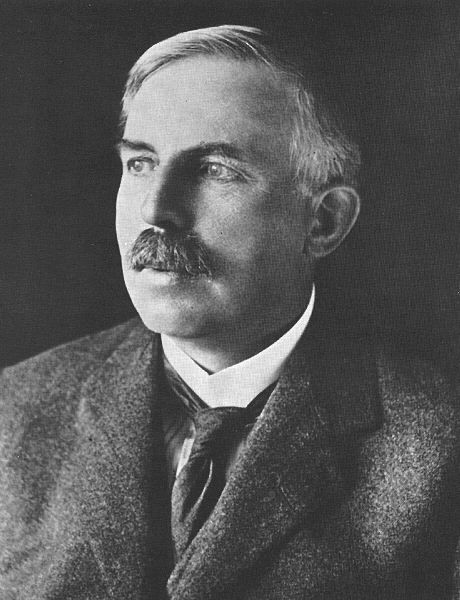Nuclear Model
Ernest Rutherford was born at Spring Grove in rural Nelson on August 30th 1871, the second son and fourth child of twelve born to James and Martha Rutherford
Martha became a teacher at the Spring Grove school where her efforts were always praised by the provincial school inspector. So Ernest Rutherford and his siblings received a good education because of parents who appreciated education: his father because he hadn't had much and his mother because she had.
Rutherford became popular among professors of different colleges, including those Manchester and Cambridge. He helped define several points and made significant contributions to scientific facts known. He also participated in war work where he contributed several war weapon models, an improvement for the cannon, for instance. Rutherford was knighted in the 1914 New Years Honours list and visited Australia and New Zealand for a scientific meeting and for a family reunion. War was declared just before he reached Australia.

In 1919 he returned to the Cavendish as Director. Under him, Nobel Prizes were awarded to Chadwick for discovering the neutron (in 1932), Cockcroft and Walton for an experiment which was to be known as splitting the atom using a particle accelerator, and Appleton for demonstrating the existence of the ionosphere. He was admitted to the Order of Merit in 1925 and in 1931 was created Baron Rutherford of Nelson, of Cambridge in the County of Cambridge, a title that became extinct upon his unexpected death in hospital following an operation for an umbilical hernia (1937). Since he was a peer, British protocol at that time required that he be operated on by a titled doctor, and the delay cost him his life. He is interred in Westminster Abbey, alongside J. J. Thomson, and near Sir Isaac Newton.
Chemical Model
In it, the atom is made up of a central charge (this is the modern atomic nucleus, though Rutherford did not use the term "nucleus" in his paper) surrounded by a cloud of (presumably) orbiting electrons. In this 1911 paper, Rutherford only commits himself to a small central region of very high positive or negative charge in the atom.
The Rutherford paper suggested that the central charge of an atom might be "proportional" to its atomic mass in hydrogen mass units u (roughly 1/2 of it, in Rutherford's model).
Gold Foil Experiment
 Ernest Rutherford publishes his atomic theory describing the atom as having a central positive nucleus surrounded by negative orbiting electrons. This model suggested that most of the mass of the atom was contained in the small nucleus, and that the rest of the atom was mostly empty space. Rutherford came to this conclusion following the results of his famous gold foil experiment. This experiment involved the firing of radioactive particles through minutely thin metal foils (notably gold) and detecting them using screens coated with zinc sulfide (a scintillator). Rutherford found that although the vast majority of particles passed straight through the foil approximately 1 in 8000 were deflected leading him to his theory that most of the atom was made up of 'empty space'.
Ernest Rutherford publishes his atomic theory describing the atom as having a central positive nucleus surrounded by negative orbiting electrons. This model suggested that most of the mass of the atom was contained in the small nucleus, and that the rest of the atom was mostly empty space. Rutherford came to this conclusion following the results of his famous gold foil experiment. This experiment involved the firing of radioactive particles through minutely thin metal foils (notably gold) and detecting them using screens coated with zinc sulfide (a scintillator). Rutherford found that although the vast majority of particles passed straight through the foil approximately 1 in 8000 were deflected leading him to his theory that most of the atom was made up of 'empty space'.To find out more about Ernest Rutherford:
"If your result needs a statistician then you should design a better experiment."
— Ernest Rutherford
BLOGGED BY:
Abad Santos, Bettina
Arguillo, Nicole
Tan, Michelle




No comments:
Post a Comment